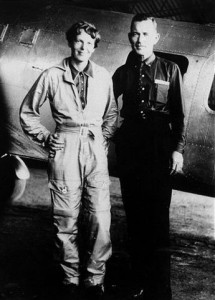
Published on July 2, 2012
KHAQQ calling Itasca. We must be on you, but cannot see you… gas is running low…”
Over 22,000 miles and 43 days after leaving Oakland, California, Amelia Earhart’s ill-fated attempt to fly around the world ended in mystery.
On July 2, 1937, at 20:14 hours GMT, the Coast Guard Cutter Itasca received the last voice transmission from Amelia. She never reached her destination at Howland Island. At 21:30 hours GMT, it was decided that Earhart’s extensively modified Lockheed Electra 10E “must have ditched into the ocean.”
Nine navy ships and 66 aircraft searched for 16 days for the downed Electra, but to no avail. No sign of the plane, Earhart, her veteran navigator Fred Noonan, nor any debris were found by the searchers. It was believed that the plane went down in the Pacific somewhere between 35 and 100 miles from Howland Island.
There have been many theories about Earhart’s disappearance, but none have ever been proven. Today, the leading theory is offered by the organization TIGHAR, which has found photographic evidence of what possibly might be the landing gear of Earhart’s Electra in the surf off of the island of Nikumaroro in the South Pacific. Based on that photo and a host of other evidence (all compelling but none yet the single “smoking gun” piece that would prove the case), the US Department of State has now lent its support to TIGHAR to make yet one more expedition to the island in search of the aircraft and the remains of both Noonan (her navigator) and Earhart.
Perhaps this time, new searchers will discover the truth about what happened to Amelia Earhart, one of aviation’s most enduring mysteries.
In a final note to her husband George that was to be opened if she did not return, she wrote:
“Please know I am quite aware of the hazards… I want to do it because I want to do it. Women must try to do things as men have tried. When they fail their failure must be but a challenge to others.”
One More Bit of Aviation Trivia
Amelia Earhart was but one of many aviators who lost their lives setting new records and pushing the limits of aviation technology. Without their sacrifices, aviation would have never advanced at the rate it did and the flight path to today’s high standards is marked by so many who were lost along the way. Their ranks include some of the greatest names in early aviation history, prompting Jimmy Doolittle (a man not only famous for his daring raid on Tokyo, but also a renowned air racer and pioneering of instrument flying) to entitle his autobiography, “I Could Never Be So Lucky Again.” In fact, it might be better to say that perhaps mankind could never be so lucky again that so many would brave that dangerous and pioneering path to the skies, knowing the risks and yet pushing on anyway. Today, with every flight of a Boeing 747 or Airbus 380 to and from Europe and Asia, we should sit back in our coach class seats and recall the debt of gratitude we owe to those early pioneers who would “kick the tires, light the fires, and go” — now, about those coach class seats….
